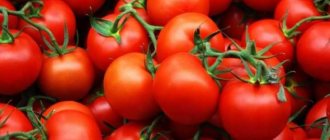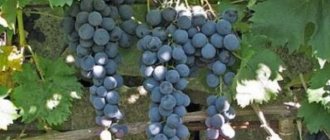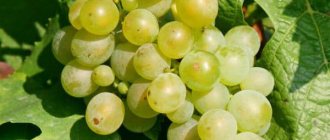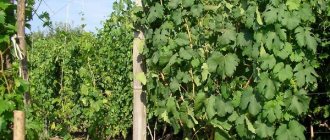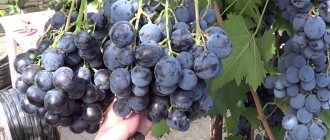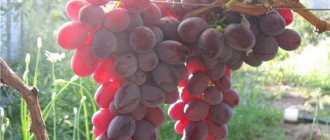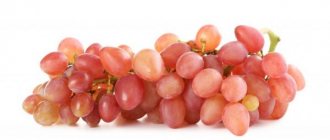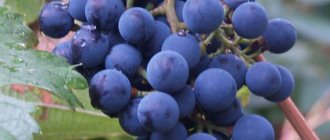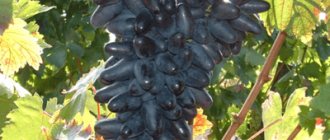History of variety development
This variety was bred by Bulgarian specialists. Other names for the grape Augustine are Phenomenon, Pleven resistant, sometimes you can also find its number – V 25/20
.
When breeding Augustine grapes, the Villars-blanc and Pleven varieties were taken as the basis. High disease resistance was transferred to the new variety from Pleven, and resistance to unfavorable climatic conditions was transferred from Villars Blanc.
Augustine grapes - photo
And although this variety was bred for the mild and warm Bulgarian climate, Augustine grapes are successfully grown by winegrowers in central Russia and even in a number of regions of Siberia.
Reviews
I consider the Augustine variety to be the best for the north of Ukraine, and for other regions too. The variety is a dream for a summer resident! Minimum effort – maximum return. Novel. Lugansk
Pleven resistant is an excellent variety, especially for beginners. To all that has been said above, I can add: a real hard worker, like Nadezhda AZOS. If overloaded, ripening is delayed for 7-10 days, but everything is pulled out without compromising weight and quality. Sergey, Rostov region
Augustine grapes: description of the variety and its main characteristics
This table grape is distinguished by its early ripening of the clusters - approximately 4 months after the appearance of young leaves. Since Augustine is a table fruit, its fruits are usually consumed fresh, without any processing.
The bushes are distinguished by their great growth vigor, very powerful, this variety is used for decorating arches and arbors.
On Augustine grape vines, female and male flowers appear simultaneously; their cross-pollination can occur even under unfavorable weather conditions
. Augustine grapes can be a good pollinator for other varieties with similar flowering periods.
Photo of Augustine grapes
The foliage is large, dark emerald in color, weakly divided, so the leaf blades are almost round in shape. During the ripening period, the vines are dotted brown in color with a red tint. Young stems develop quickly and there are a lot of them. Before the onset of cold weather, at least 95% of the shoots become lignified.
On a note!
Augustine's grape clusters during ripening can weigh up to 0.8 kg; with proper care, the weight of the bunches can be even greater. Their maturation is amicable, almost simultaneous.
The clusters are of medium looseness, with moderate density, sometimes with a wing. Such brushes are better ventilated, so the likelihood of developing diseases is reduced. These grapes are not prone to peas; all berries are approximately the same size and weight. On average, the weight of one fruit is up to 8 g, which is a large size for the middle zone or Siberian region. Each berry has up to 5-6 seeds. The skin is of medium density and is practically not noticeable in food.
Productivity and ripening time
The plant produces its first signal harvest in the 2nd year after planting, marketable fruiting begins in the 4th - one bush yields an average of 25-30 kg.
In industrial plantings, "Augustine" demonstrates high productivity and is capable of producing yields of about 18 t/ha
Removable maturity occurs 130-140 days after bud break . The bunches remain on the bush for 2-3 weeks without deteriorating the quality of the fruit, which means you can confidently carry out an extended grape harvest. The berries are firmly held on the stalks and do not fall off.
In the southern regions, the harvest reaches its highest quality in the second ten days of August, and in cooler regions - in the first ten days of September. Properly harvested fruits practically do not spoil and can be stored well in the refrigerator for more than 2 months. The juicy pulp is perfectly protected from damage by the dense skin, which is not damaged during transportation, so the variety is recommended primarily for industrial cultivation for commercial purposes.
The opinion of an experienced Ukrainian gardener about the yield potential can be found in the following video:
Diseases and pests
Augustine grapes are highly resistant to all major fungal diseases, especially mildew and oidium, which cause significant harm to other grape varieties. Therefore, the vines of this grape do not require preventive treatments.
Pests also do not appear on Augustine grapes.
Advantages of the variety
The main advantages of the Augustine grape variety include:
- high productivity;
- early harvest ripening;
- good taste of ripe Augustine grape fruits;
- excellent presentation of ripe bunches;
- ripe clusters can hang on the vines for up to 2 weeks without falling off or losing their presentation and taste;
- the variety is highly resistant to most fungal diseases, including mildew and oidium;
- Fruiting is stable, annual;
- large weight of ripe brushes (up to 1 kg);
- Augustine grapes have relatively high frost resistance (up to -24 degrees);
- The variety is not susceptible to peas.
Some negative qualities of Augustine grapes should be noted:
- with a long rainy season during the ripening period, the berries may crack;
- sufficiently large size of the seeds;
- this table variety is not suitable for making homemade wines;
- After ripening, you should not keep the bunches on the vines for more than 2 weeks - the ripe berries begin to crumble.
Advantages and disadvantages
- huge yield - up to 50 kg per bush;
- high quality of taste and structure of berries;
- ease of transportation;
- the ability to decorate arches, gazebos and other structures;
- high frost and disease resistance;
- good resistance to diseases and pests.
- the skin often cracks after rains;
- it is necessary to devote a lot of time to pruning a rapidly growing vine;
- The plant requires frequent, deep watering at some stages of its life.
Augustine: planting grapes
To plant in your garden, it is better to purchase two-year-old Augustine seedlings from specialized nurseries.
The place for planting these grapes should be illuminated by the sun all day - the more sunlight, the more sugars are formed in the fruits, the fruiting will be more abundant, and the ripening period of the bunches will be earlier.
Important!
In the conditions of the middle zone and Siberian regions, Augustine grapes are planted only in the spring, so that the young plants get stronger before the beginning of winter.
The main nutrition to the vines comes from the heel roots, but the surface roots (dew roots) are also very important. To prevent them from freezing out in frosty winters, the depth of the planting holes should be at least 0.8 m.
Before planting, a nutrient soil mixture consisting of 20 kg of humus and 300 g of superphosphate and potassium salt is placed in each hole before planting.
Planting a grape seedling
A layer of drainage 8-9 cm thick is laid on the bottom, then a layer of nutrient substrate on which the seedling is installed. When filling the planting hole, you need to make sure that the root collar is 1.5-2 cm above ground level.
After planting, water the plants, pouring at least 1 bucket of water under each one. Watering is done weekly until the grapes acclimatize to the new location.
Features of cultivation
This variety is quite undemanding and is suitable even for beginner winegrowers. “Augustine” loves abundant watering, but this should be done carefully so as not to flood the bush. If there is too much moisture, the grapes may crack.
Soil and planting
When growing Augustine, the main thing is to choose the right planting site. This should be a sunny area protected from strong winds. The amount of light determines the speed of fruit ripening, as well as their taste - berries grown in the shade contain much less sugar.
The variety prefers moist and nutritious soil - loamy or chernozem soil is optimal for it. You can plant either cuttings or small bushes. This should be done in early spring after above-zero temperatures have set in, or in the fall before the onset of cold weather.
Reference! It is preferable to carry out the procedure in early May - this makes it easier for the plant to adapt, the root system will have time to strengthen before frost and fruiting will begin earlier.
Recommendations for planting:
- The parameters of the planting hole are at least 80x80x80 cm. It should be prepared several weeks before the procedure.
- Drainage is required, the layer of which should be at least 10-15 cm.
- Maintain a distance between plants of more than 1.5 m, between rows - 2-3 m.
- 10-14 days before planting, the cuttings should be immersed in water to allow them to become saturated with moisture.
- It is important not to cover the root collar with soil.
- The soil needs to be compacted.
- The surface of the pit must be mulched.
- It is recommended to water the young plant once every 7 days until it takes root.
Immediately after planting, you need to provide the future bush with support along which the vine will rise to the top.
Trimming
Shoots of this variety require regular sanitary and decorative pruning. Thinning helps you get a larger harvest.
Formation on a trellis:
| Period | Sequencing |
| 1st year | leave 2 shoots - cut them into 3-4 buds in the fall |
| 2nd year | leave 4 vines, after harvesting, shorten them slightly |
| 3rd year | form a fruit arrow and a replacement knot on each vine |
| 4th and subsequent years | on shoots that have grown from a replacement knot, leave a new branch and arrow, cutting off the old ones. |
In order for “Augustine” to wrap around the arch beautifully, you need to:
- Trim the bush into 2 sleeves, leaving 12-14 eyes on each.
- Make sure that the length of the sleeves increases annually to half a meter.
- Form more than 5 shoots with 2-4 eyes on each sleeve.
Thanks to the good growth that is inherent in the variety, the vine will quickly stretch and wrap around the frame. More details about how to properly trim grapes on an arch can be found in a separate article.
During the summer it is necessary to pinch the stepsons:
- There should be 5-6 leaves per 1 brush.
- Second-order stepchildren should be removed.
- At the end of August you need to pinch off the tops.
The combination of these actions will help the vine to ripen better.
Watering
Despite the relative resistance of the variety to drought, it needs watering, especially during periods of prolonged absence of rain. Watering rates depend on:
- Age of the bush - young shoots need moisture more.
- Vegetation stage - the plant needs the most water during the period of active growth and flowering.
- Type of substrate - do not allow it to dry out or become waterlogged.
Reference! In order for the soil to retain moisture longer, it is worth mulching.
Diseases and pests of “chaff resistant”
“Pleven” withstands weather disasters and grows well in rather harsh climatic zones. However, many winegrowers note that these grapes are prone to certain diseases. According to the stability classification, it is rated at 2.5-3 points.
The main dangers for the vineyard are:
- Phylloxera.
- Grasshopper.
- Gray rot.
- Oidium.
- Mildew.
- Birds.
Spraying the bush with insecticides and various chemicals is used against insect pests and fungal infections. For example, Bordeaux mixture, copper or iron sulfate, slaked lime.
To prevent birds from pecking at the crop, the bushes are completely covered with synthetic mesh or nylon tights are placed on each bunch.
Shelter for the winter
“Augustine” is a fairly frost-resistant grape variety. Therefore, in the conditions of the southern regions and central Russia, the bushes do not need winter shelter.
In the Urals and Siberia, where the climate is more severe and winter temperatures often drop below this level, it is worth taking care in advance of covering the vines during the cold season.
Harvest storage
After ripening, the crop may not spoil on the bushes for up to 2 weeks. The dense skin ensures good attachment of the berries to the stalks. The grapes are easily transported in boxes and retain their presentation for a long time.
Regions
“Pleven” was bred for cultivation in the southern regions. But thanks to good frost resistance, the ability to pollinate and accumulate sugar even in rainy weather, as well as the early ripening of fruits, its cultivation has become possible in the more northern regions of our country. This variety is grown in the Moscow region, the Volga region, the Urals and Siberia.
Further care for the Augustine grape variety
Further care of the Augustine vineyard comes down to regular watering, loosening, weeding, fertilizing, pruning
. An important stage in the process of caring for this garden plant in regions with harsh winters is preparing the vineyard for winter with the obligatory covering of the vines.
Although the Augustine variety is quite resistant to periods of drought, it is necessary to water in hot and dry times. This grape is especially demanding of moisture during the period of active shoot growth and flowering.
During the rainy season, the amount of watering is reduced, and approximately two weeks before harvesting, it is stopped completely.
How to feed Augustine grapes
In the first season after planting, young plants do not need to be fed - the fertilizers that were applied during planting are quite enough for them.
In the following seasons, the Augustine grape variety needs to be fertilized three times per season:
- the first fertilizing is carried out in the spring, introducing nitrogen-containing fertilizers into the tree trunk circles;
- The next fertilizing is applied 12-14 days before flowering. Phosphorus compounds should predominate in its composition;
- The last time a complex mineral compound is added to Augustine grapes is during the ripening period. During this period, grapes need potassium salts and superphosphate.
When applying fertilizers, you must adhere to the dosages specified in the instructions for the preparations. The amount of fertilizer applied must not be exceeded.
You can also foliar feed Augustine vines once or twice a season with a solution of mineral fertilizers.
Appearance
A description of the Augustine grape will help to study its external characteristics in more detail. The shoots are powerful and mature by more than half in one season. The branches are bisexual, that is, self-pollinating. The leaves are round in shape, dark green in color. The vine is brown, with a reddish tint.
The sweet harvest attracts arthropods. Wasps and bees devour the fruits of the grape plant. Harvesting should be done immediately after ripening.
The ripening bunches have a slightly elongated shape. The weight of one berry reaches 8 grams. The peel is thick. The pulp is juicy and sweet. Ripe berries have a delicate and light taste. Each of them contains up to 3 seeds.
Ripe bunch of Augustine grapes
Augustine grapes: how to prune correctly
Since this variety grows a large number of young shoots per season, it is impossible to do without annual formative pruning of Augustine grapes. Without it, the vines will become thickened, the berries will become smaller, and as a result, the yield will sharply decrease.
In the first season after planting, seedlings do not form - they must grow a sufficient number of shoots.
In the following years, Augustine bushes are formed according to the chosen pattern. In the fall, all shoots are cut off, leaving 7 to 12 eyes on each.
In the spring, such a procedure is not recommended unless absolutely necessary - juice begins to move in the vines, and juice may flow out of the cuts.
In the summer, you only need to pinch the stepsons to regulate the number of shoots formed. The yield of this variety is high, so up to 6 leaves should be left above each brush.
To prevent thickening of the bush, all second-order stepsons are removed.
At the end of August, the tops of the shoots are pinched so that they ripen better.


